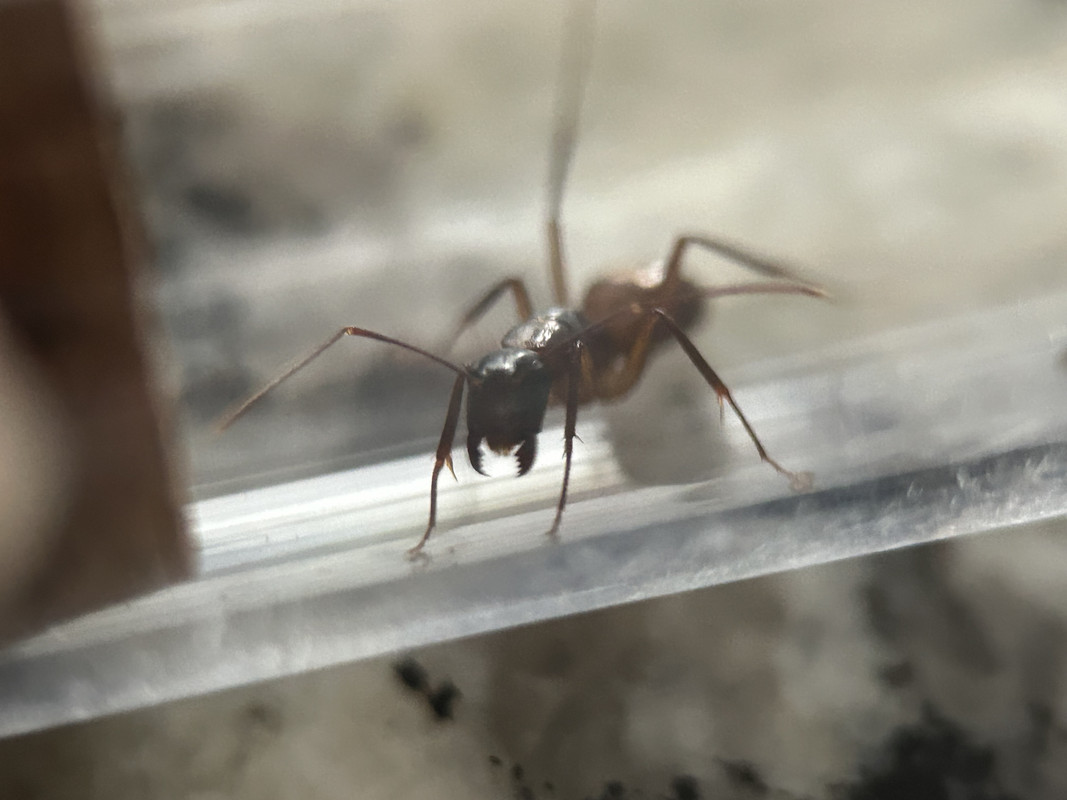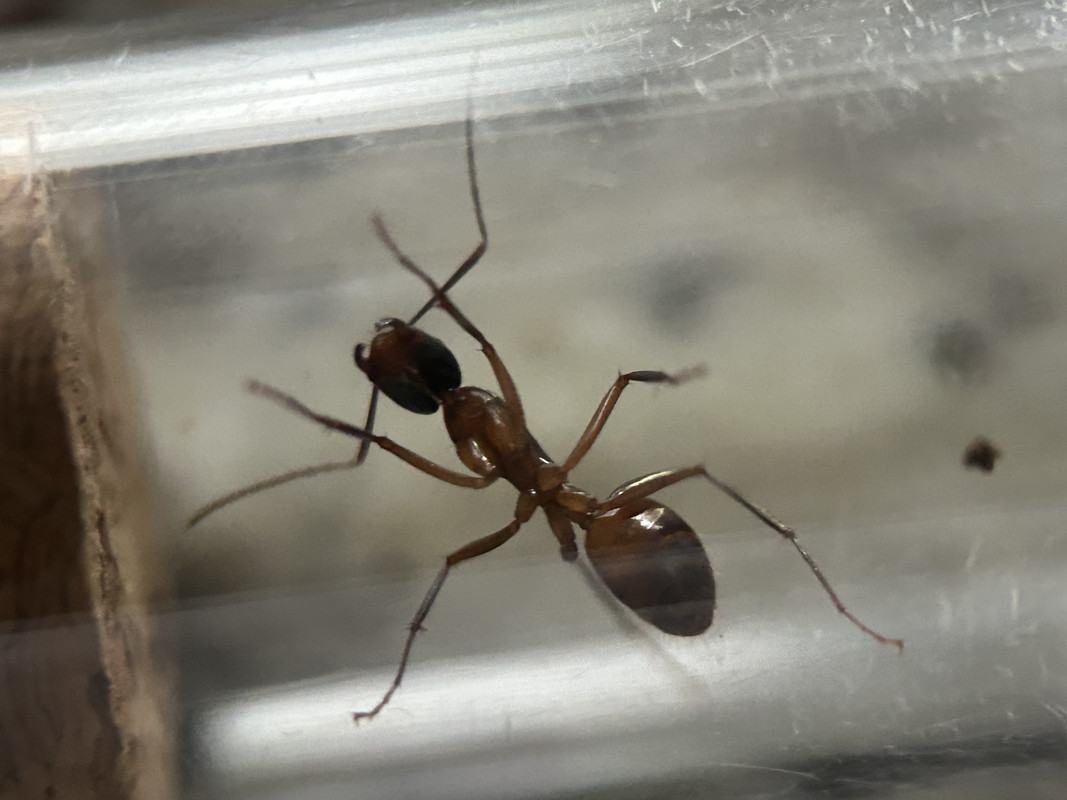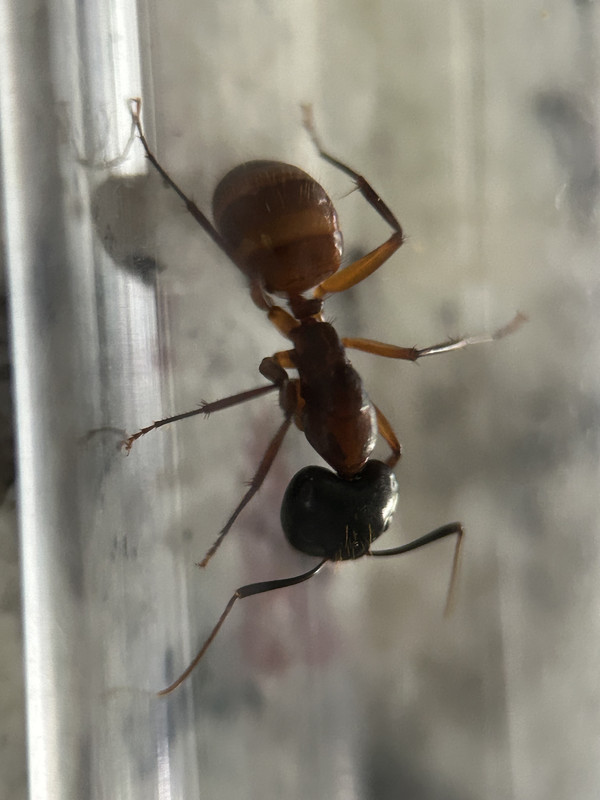1. Dallas
2. 3/15/25
3. Forest
4. Worker 8-12mm, Major 14-18mm, Queen 19-22m
5. Orange, red, and black
6. Larger than any other Camponotus I've seen
7. Calm
8. Under a rock
9. ?




Thanks!

1. Dallas
2. 3/15/25
3. Forest
4. Worker 8-12mm, Major 14-18mm, Queen 19-22m
5. Orange, red, and black
6. Larger than any other Camponotus I've seen
7. Calm
8. Under a rock
9. ?




Thanks!
Keeping:
Atta texana x2, Pheidole absurda x4, Neoponera villosa x7, Psuedomyrmex gracilis, Odontomachus clarus, Pheidole tepicana x5, Mycetomoelerrius turrifex x30, Trachymyrmex septentrionalis, Myrmecocystus mexicanus x4, Myrmecocystus placodops-03, Myrmecocystus kennedyi, Myrmecocystus navajo, Myrmecocystus mimicus (Caramel) x2, Camponotus atriceps 2q, Camponotus ocreatus, Camponotus sansabeanus x4, Camponotus festinatus, Camponotus pennsylvanicus, Camponotus texanus, Novomessor albisetosus, Pogonomyrmex comanche x7, Leptogenys elongata, a ton of other random ants
camponotus sansabeanus, it seems to be the closest match that I can get, it is native to Texas, the casts are all matching to the sizes you provided, and the coloration of the major and minor workers look similar to the pictures
Currently keeping:
1x Formica subsericea, 35-40 workers + maybe eggs *New* 2x Camponotus nova, one has only larva
1x Crematogaster cerasi, All workers is ded ![]() *extreme internal screaming* 1x Myrmica ruba sp around 10 workers + pupa
*extreme internal screaming* 1x Myrmica ruba sp around 10 workers + pupa
*New* 1x Temnothorax curvispinosus, 101 or something worker + 3 or 4 royal mom ants + pile of white ant worms
*As you watch your ants march, remember that every thing begins with a small step and continued by diligence and shared dreams* -A.T (which is Me)
Sadly due to unforeseen consequences, I will soon be giving away my colonies (I will miss them though ![]() )
)
I would look into comparing it to C. americanus as well. It does not look like C. sansabeanus to me nor are the measurements anywhere near the size of C. sansabeanus. Do you have a ruler you can measure them with? Such large estimate size ranges aren't helpful, unfortunately.
They probably are C. americanus. I didn't think of that species when I was trying to ID them myself. Sadly, I already let them go so I can't measure them. The only way they wouldn't be C. americanus is because they are huge.
Keeping:
Atta texana x2, Pheidole absurda x4, Neoponera villosa x7, Psuedomyrmex gracilis, Odontomachus clarus, Pheidole tepicana x5, Mycetomoelerrius turrifex x30, Trachymyrmex septentrionalis, Myrmecocystus mexicanus x4, Myrmecocystus placodops-03, Myrmecocystus kennedyi, Myrmecocystus navajo, Myrmecocystus mimicus (Caramel) x2, Camponotus atriceps 2q, Camponotus ocreatus, Camponotus sansabeanus x4, Camponotus festinatus, Camponotus pennsylvanicus, Camponotus texanus, Novomessor albisetosus, Pogonomyrmex comanche x7, Leptogenys elongata, a ton of other random ants
I was pretty sure that it was C. sansabeanus was more likely because the size of C. sansabeanus matches the size provided and the major looked to be C. sansabeanus because of how its head was more wide and square looking in the photos, unlike C. americanus which is more round. But is you determined it is C. americanus, I will not argue against it.
Edited by OwlThatLikesAnts, March 16 2025 - 7:39 AM.
Currently keeping:
1x Formica subsericea, 35-40 workers + maybe eggs *New* 2x Camponotus nova, one has only larva
1x Crematogaster cerasi, All workers is ded ![]() *extreme internal screaming* 1x Myrmica ruba sp around 10 workers + pupa
*extreme internal screaming* 1x Myrmica ruba sp around 10 workers + pupa
*New* 1x Temnothorax curvispinosus, 101 or something worker + 3 or 4 royal mom ants + pile of white ant worms
*As you watch your ants march, remember that every thing begins with a small step and continued by diligence and shared dreams* -A.T (which is Me)
Sadly due to unforeseen consequences, I will soon be giving away my colonies (I will miss them though ![]() )
)
I was pretty sure that it was C. sansabeanus was more likely because the size of C. sansabeanus matches the size provided and the major looked to be C. sansabeanus because of how its head was more wide and square looking in the photos, unlike C. americanus which is more round. But is you determined it is C. americanus, I will not argue against it.

From AntWiki. That major is around 10 mm long. According to OP, majors in question are 14-18 mm long. sansabeanus is too small in all castes. I third americanus.
"God made..... all the creatures that move along the ground according to their kinds (including ants). And God saw that it was good. Genesis 1:25 NIV version
Keeping:
Tetramorium immigrans Camponotus vicinus, modoc, novaeboracensis, herculeanus
Formica pallidefulva, argentea Solenopsis molesta
Formica cf. aserva Lasius brevicornis, neoniger
I’m confused, am I seeing the same thing? Because when I search up their size, it says workers: 6-12mm, majors: 13-17mm and queens: 16-19mm and not just on one site but multiple…
Currently keeping:
1x Formica subsericea, 35-40 workers + maybe eggs *New* 2x Camponotus nova, one has only larva
1x Crematogaster cerasi, All workers is ded ![]() *extreme internal screaming* 1x Myrmica ruba sp around 10 workers + pupa
*extreme internal screaming* 1x Myrmica ruba sp around 10 workers + pupa
*New* 1x Temnothorax curvispinosus, 101 or something worker + 3 or 4 royal mom ants + pile of white ant worms
*As you watch your ants march, remember that every thing begins with a small step and continued by diligence and shared dreams* -A.T (which is Me)
Sadly due to unforeseen consequences, I will soon be giving away my colonies (I will miss them though ![]() )
)
I was pretty sure that it was C. sansabeanus was more likely because the size of C. sansabeanus matches the size provided and the major looked to be C. sansabeanus because of how its head was more wide and square looking in the photos, unlike C. americanus which is more round. But is you determined it is C. americanus, I will not argue against it.
The description of C. sansabeanus (type locale being San Saba County, Texas, where the taxon 'sansabeanus' is derived from) states gynes to be 0.62 inches [=15.75 mm] and "workers" to be 0.46 inches [=11.68 mm] in total length -- majors do get larger, but this clearly shows how the sizes you found are erroneous. The faulty measurements you found are from this website (I looked through the first 5 pages of Google and no site had measurements that gave the same numbers as you provided other than this one site), an Old World sales site, which are known to have extremely erroneous measurements. Just for an example, this site gives a minimum gyne measurement of 12 mm. If the specimens are extremely physogastric, these measurements will be larger, but physogstric measurements are not representative of the true size of the ants. The major caste of C. sansabeanus is around 15 mm with slight variation. Head shape is also not possible to determine with the photos, since none of the photos are remotely close to front-on.
Camponotus identification, and ant identification in general, can be a bit tricky as it usually is based on minute details such as hair count, hair inclination, punctate density or size, integument sculpturing, and other details that are sometimes no larger than 0.01 mm. Camponotus in the US is a good example as there is numerous species that differ by only a few hairs and have been plagued by shotty taxonomic work through the past almost two centuries at this point.
Ahhhh, thanks for the clarification! I guess I need to do better research and also go to sites with better sources
Currently keeping:
1x Formica subsericea, 35-40 workers + maybe eggs *New* 2x Camponotus nova, one has only larva
1x Crematogaster cerasi, All workers is ded ![]() *extreme internal screaming* 1x Myrmica ruba sp around 10 workers + pupa
*extreme internal screaming* 1x Myrmica ruba sp around 10 workers + pupa
*New* 1x Temnothorax curvispinosus, 101 or something worker + 3 or 4 royal mom ants + pile of white ant worms
*As you watch your ants march, remember that every thing begins with a small step and continued by diligence and shared dreams* -A.T (which is Me)
Sadly due to unforeseen consequences, I will soon be giving away my colonies (I will miss them though ![]() )
)
0 members, 1 guests, 0 anonymous users